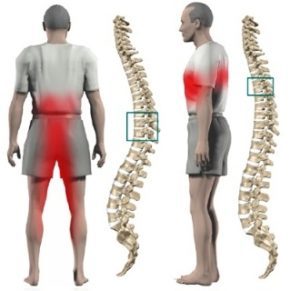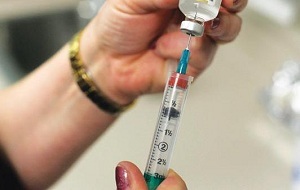Lumbar spinal cord tumors, symptoms and treatments are very diverse, is one of the most common diseases of the musculoskeletal system.
This condition is characterized by the development of degenerative-dystrophic changes in the intervertebral disc, spreading over time to the ligaments and bone tissue of the vertebrae of the spine. An acute course, without treatment, inevitably turns into chronic.
Degenerative diseases can turn a healthy person into a disabled person.
Degree of lumbar spine necrosis
Classifies 4 levels of bone necrosis of the circular muscle region. The schematic diagram of the disease is as follows:
First degree.In the inner part of the annular fiber, fracture-like lesions are formed, where substances contained in the pulp nucleus enter, causing irritation. This is the first stage of bone necrosis. Distortion of the disc is barely noticeable and causes reflex pain during sudden movements and heavy lifting. Discomfort in the lower spine can be mild and manifest:

- paralysis - local, persistent pain in the lumbar spine;
- low back pain - sudden "low back pain" pain in your lower back.
The second degree.Destructive processes in the ring fiber continue. The distance from one vertebra to another is reduced, causing compression on nerve fibers. There is a feeling of discomfort in the lower third of the back, sometimes developing into pain.
The third degree.During this stage, final annihilation of the annular fiber occurs with extrusion of the myeloid nucleus. Nerve vessels and ends are compressed by the disc. Disc herniations are formed. The spine is bent, forming:
- fibroids - arc distortion in the lumbar spine, with the spine bulging anteriorly;
- kyphosis - position opposite to curvature, when the arc is formed in the outward direction;
- scoliosis - curvature of the spine to the right or left.
Ultimate degreeosteonecrosis is considered the most serious and dangerous. At this time, the spine is deformed, losing normal motor activity. X-rays show the growth of bones in the lumbar spine - the body's response. The pain may go away in a while, but that doesn't mean it will improve. People with stage 4 of the bone necrosis disease of the lumbar spine are often disabled. The reason is that at this stage the process is complex.
Causes of lumbar spine necrosis
Among the causes of lumbar necrosis are:
- Disproportionate load on the spine.Humans are erectile creatures, so in an upright position, the load on the spine is considered normal. When performing different movements, you have to move, bend and not bend down, to maintain the body in the desired condition, the musculoskeletal system is in a stretched mode. In a sitting position, the load on the spine increases, and when lying on your back it becomes minimal. When a person stays in the same position for a long time, the lumbar and sacral parts of the spine are overloaded and the muscles are not resting, from which there is discomfort and then pain. This deformation factor creates a premise for the development of lumbar necrosis.
- Sedentary lifestyle.It contributes to the development of various diseases, including those that affect the structure of the vertebrae. Long sitting causes cartilage tissue deformation and decreased muscle tone, stimulates the development of bone necrosis in the lumbar region.
- Excessive physical activity.Neither the lack of vigorous physical activity nor excessive physical activity does anything good for the musculoskeletal system. Long, hard work, especially lifting and carrying weights, leads to overactive back muscles and the formation of a spinal hernia.
- Postural disturbances.Distortion between the vertebrae can also be caused by improper walking. This is due to an uneven load on the spine. Disc loss of elasticity, mobility, and therefore more susceptible to damage. More than others, the elderly and the elderly suffer from similar problems.
- Bone defects, genetic diseases, trauma, and infectious lesions.Usually, bone necrosis is the result of disorders of the musculoskeletal system at birth. For example, when the body's cartilage tissues are naturally fragile. In addition, pathologies of the spine develop after trauma due to trauma and infectious processes, as in osteomyelitis and tuberculosis.
- Flat feet.The sign of a "special" foot is that it is not arched and that its arch is concave. People with such traits often experience spinal problems. This is because the load on the discs increases when walking. Throughout their lives, they suffer from increased physical stress during exercise, so they quickly wear out
- Obesity.Excess weight is an issue and an additional burden on the body. All organs and systems are affected, including the spine.
- Pathological processes.Disorders of various structures can adversely affect the condition of the musculoskeletal system. So the factors that cause lumbar spine degeneration are endocrine disorders, cardiovascular problems and digestive system malfunctions.
- Wrong way of life.Many people do not pay enough attention to simple and important things like physical activity, balanced nutrition and normal sleep. An organism that survives for a long time under stress becomes weakened and vulnerable. Among other diseases that can arise on such "fertile" soil, must be lumbar necrosis disease.
Symptoms of lumbar spine necrosis

Pathological changes in the lumbar spine are manifested by severe symptoms;
- Lower back painis the clearest “signal” of the development of lumbar tumors. She talks of the presence of "lens syndrome", when compression of the nerve ends of the spine causes pain in the lumbar region. People became tired and irritable. Over time, performing simple and routine activities becomes a major problem due to pain in the lumbar spine. If a disc herniation has formed in the lumbar region, pain spreads down the lower legs, back of the thighs, and feet. Over time, sitting and walking becomes more and more difficult. Discomfort doesn't let go even when lying down. Temporary relief may intersperse with episodes of exacerbations. ;
- dysfunction of the genitourinary system.They are manifested by pain in the kidney area, frequent urge to urinate. Deformation of the disc causes displacement of the lumbar spine relative to the sacrum. This affects the work of the internal reproductive organs in women, and in men, it causes problems of potency;
- reduces the sensitivity of the foot in the foot area.It can be partial or absolute. At the same time, the reflexes of this part of the body are also impaired. Progressive pathology leads to complete loss of sensitivity of the lower extremities;
- A gait disorder.Lumbar spinal pain accompanied by osteoporosis causes the patient to move sideways to the opposite side opposite to the pinched nerve fibers. The condition does not allow hiking. A lame person was forced to stop again and again in order to relieve the pain. Prompt medical assistance can save a person from a disability.
Treatment of lumbar spinal necrosis
Many people are wondering if lumbar fibroids can be treated and how it happens. When a diagnosis is made and a diagnosis is made, the strategies of treatment are determined.
There are various methods used to treat lumbar necrosis. A doctor determines which of these is necessary and should be applied to cure or alleviate a person's condition.
Someone self-treating with folk remedies at home forgets that they can only be used with the approval of a medical professional and is only part of complex therapy.
Medicines for osteonecrosis
Drug therapy involves the use of:
- as tablets;
- injection solution; Preparations
- for external use - ointments and gels.
Drugs are prescribed to eliminate inflammation and relieve pain in the lumbar spine. They can be used at home.

This could be:
- pain reliever;
- nonsteroidal anti-inflammatory drug;
- drugs that treat muscle spasms (muscle relaxants);
- means cartilage tissue restoration (chondroprotectors);
- corticosteroids (hormone-containing drugs that reduce pain and inflammation)
- vitamins.
A course of treatment prescribed by a doctor, sometimes prescribing medicine or medicine to calm the nervous system as an additional treatment.
Physiotherapy for lumbar necrosis
Physiotherapy is another popular method for relieving lumbar necrosis symptoms. Work on the spine and lower back, helping to increase metabolism and recovery.
Most commonly prescribed:
- magnetotherapy, laser and electrical therapy; electrophoresis
- ;
- shock wave method;
- detensor therapy; vibrating massage
- ;
- therapy.
How much and what procedures are needed - the doctor decides.
Physiotherapy is effective in the early stages of the pathology. But she, like other types of treatment, has contraindications. Therefore, when appointing this method, the doctor takes into account many factors.
Gymnastics for lumbar tumors
A set of exercises that can be used in lumbar manipulation to restore the mobility of this spine.
Regularity is considered to be the main condition for its effectiveness. Exercises performed occasionally will not be as effective as expected.
If there are complications from bone necrosis in your body, do not use this method. In addition, contraindications to its use are serious pathologies of other organs and systems, as well as the presence of pain in the pelvic region upwards.
Surgical intervention for lumbar spine tumors
A surgical approach to be used in the case of severe complications such as disc herniation. Partial or complete removal of the damaged disc (surgical resection) is performed, according to the operating procedure.
The surgical indications are:
- Strong and persistent pain syndrome
- , which cannot be cured with medicine in one month;
- large size of herniated mass and its effect on the spinal cord.
Bone tumors are easier to prevent than cure. Like any medical condition, there is a risk of serious complications. It is important to understand that more or less complete elimination of this pathology is possible at the earliest stage, when the effect of deformation on the disc is minimal. In other cases, we can only talk about relieving symptoms and maintaining the state of the body, allowing you to live and work normally.












































